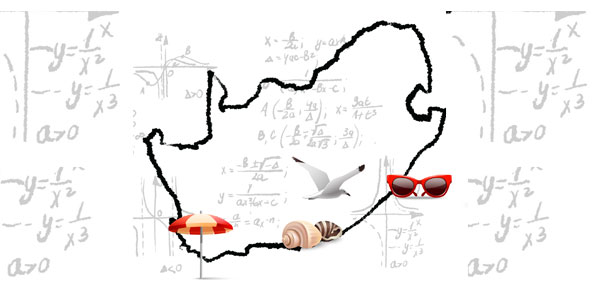Mathematics solutions to boost tourism numbers
- Refilwe Mabula
Numbers in tourism translate into revenue for the sector. Mathematicians are now number-crunching creatively to solve tourism challenges.

South Africa has a healthy tourism industry that contributes significantly to the country’s gross domestic product (GDP), but the Covid-19 pandemic has had dire financial consequences for the sector and led to substantial job losses. The travel ban imposed in March 2020 as part of the government’s lockdown measures led to a massive decline in tourism activities.
International and interprovincial travel was prohibited to curb the spread of the virus, which adversely affected the tourism sector’s revenue. Statistics South Africa says that the tourism sector contributed R130.1 billion to GDP and 4.5% of total employment in 2018. Due to the pandemic, the number of tourists plunged from 10.2 million in 2019 to 2.8 million in 2020. Although travel restrictions have started to ease in 2021, the sector is battling to recover.
It may seem an unlikely solution, but a group of maths wizards are using their skills to tackle South Africa’s tourism challenges.
The wizards convened in February 2021 at the annual Mathematics in Industry Group (MISG) hosted by the School of Computer Science and Applied Mathematics at Wits. The MISG is a five-day workshop where leading applied mathematicians and graduate students work collaboratively with representatives from industry on research problems.
This year, four problems were submitted of which two related to the problems affecting the tourism sector.
Specialised packages for domestic tourism
As the lockdown levels eased towards the end of 2020, the Minister of Tourism Mmamoloko Kubayi-Ngubane re-opened tourism activities in a quest to save jobs and to restore economic activity. But foreign travel was still curtailed and domestic tourism uptake has been low.
Dr Precious Shabalala from the University of Mpumalanga submitted the problem of low domestic tourism in Mpumalanga, which relies on tourists from other provinces.
The MISG group members, Mathew Aibinu, Keegan Anderson, Kesaobaka Moipolai, Beaullah Mugwangwavari, Zachary Njuguna and Patrick Tchepmo investigated how customised packages of tourism products and services could be used to attract the domestic market.
Using eight industries that support the tourism sector as variables, the group took a generalist approach to solve the problem of encouraging domestic tourism and creating value for money.
“We asked the question: What would encourage a local person to be a domestic tourist? This question is more specifically aimed at touring within their own province rather than visiting another province,” said the group members. However, the solution could be applicable to other provinces, which is why the group took a generalist approach.
The group made use of mathematical modelling to build affordable customised packages that could revive the tourism sector and contribute to economic growth. They modelled the package cost function using the number of tourists as the only independent variable. The solution was to offer packages to smaller groups of three to four people, and to cater for locals who do not need accommodation.
SA tourism climate index
Several factors contribute to tourism numbers and activities, one of which is climate. Tourism is seasonal and peaks during warmer weather and declines in colder conditions. Tourists consider climate when choosing their destinations.
To simplify the decision for tourists, the MISG group attempted to classify destinations using climate. The problem-solvers, with participants from South Africa and India, were tasked with developing a southern African Tourism Climate Index to assist the tourism sector with marketing and tourists with choosing their destinations.
The development of a climate index in SA will “allow the tourism sector to effectively market for the optimal tourist-climate seasons, to adapt to ensure comfortable and pleasant climactic conditions for tourists, and to develop tourist routes to maximise periods of optimal climate for specific attractions and activities,” says Professor Jennifer Fitchett from the Wits School of Geography, Archaeology and Environmental Sciences. Fitchett, whose research interests include the analyses of the impacts of climate change on tourism, submitted the tourism and climate problem for MISG 2021 to solve.
Study groups modified the Tourism Climate Index (TCI) used in Europe to suit South African weather conditions. The team used five climate indices – maximum temperature, minimum temperature, precipitation, cloud cover, and wind speed – as the inputs to estimate the values of the Tourism Climate Index for South Africa. The study group recommended additional specific tourism indices such as the Holiday Climate Index, Beach Climate Index and Camping Climate Index for South Africa.
“Research on tourism and climate change is heavily reliant on indices to quantify the role that climate plays in determining the suitability of a destination for tourism and tourists’ enjoyment of their stay at a given location,” says Fitchett.
A locally developed TCI is important given the uniqueness of our climate.
Professor Emeritus David Mason, a celebrated academic in the field of applied mathematics and founder of the MISG in South Africa, says that the MISG has been effective.
“It has introduced new problems for teaching and research. It has had an impact in industries, for example the sugar industry. Sometimes representatives from the sugar industry present our results at conferences. In the mining industry, we have worked on problems related to safety and mines.”
- Refilwe Mabula is Communications Officer for Wits University.
- This article first appeared in Curiosity, a research magazine produced by Wits Communications and the Research Office.
- Read more in the 12th issue, themed: #Solutions. We explore #WitsForGood solutions to the structural, political and socioeconomic challenges that persist in South Africa, and we are encouraged by astounding ‘moonshot moments’ where Witsies are advancing science, health, engineering, technology and innovation.

